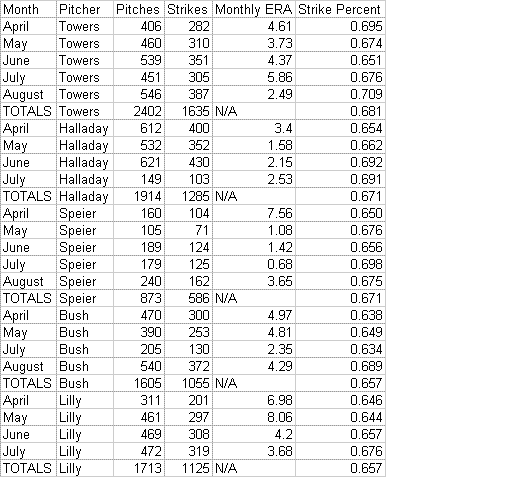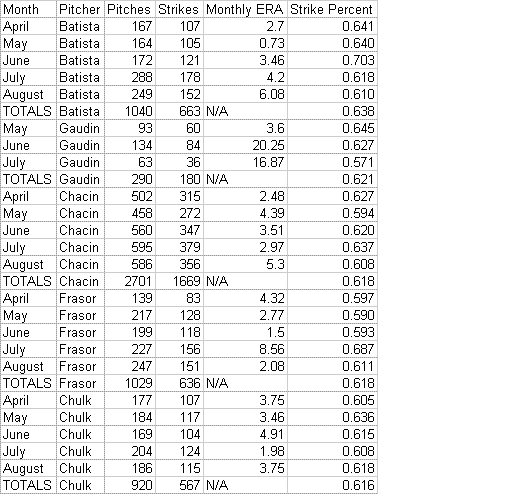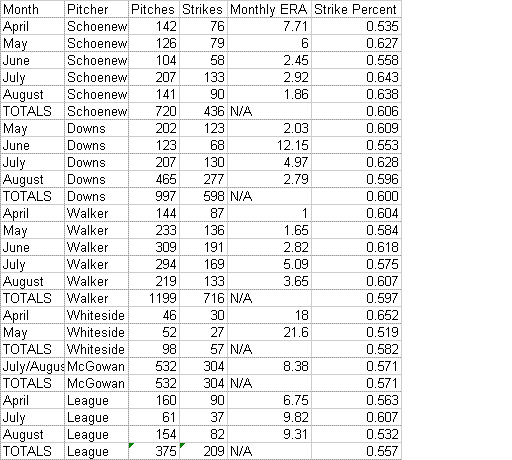It doesn’t matter much anymore, but this loss was particularly painful on top of the fact that Batista blew a second save against the Devil Rays in eight days. The added downside of this loss came because of Gustavo Chacin’s performance and the fact he didn’t pick up the victory. In what is shaping to be a very wide-open AL rookie of the year race Chacin was probably the frontrunner in late July. However, a below-average August and the difficulty he’s had winning games since then look like they’ll cost him.
Other notable contenders for the award include Huston Street, Dan Johnson, Joe Blanton (although his lack of wins will also cost him), Tadahito Iguchi, Russ Adams, Jonny Gomes and Chris Young. That doesn’t even count Robinson Cano, who might pick up a few votes because of New York hype. With so many names in the hat, I think if Chacin ends up will 12 wins or so it will cost him compared to the pretty numbers of a number of these candidates, most notably Street and Iguchi. If Chacin was on 15 or 16 wins I think it would be a whole different story, but the reality of the voters is that wins play some factor in their decision-making process. And that’s why Batista’s failure to clinch Chacin’s win is going to come back to haunt them.
I talked about Rick Short before, but most of you are probably asking yourself, who is Rick Short? And why would you like someone with the same name as Jobu’s loser friend? Well, Rick Short is a career minor-leaguer who had played 11+ seasons in the minors through June 9, 2005, amassing some pretty nice totals. He had accumulated 1,235 hits, 84 homers and 583 RBIs with a batting average over .300. On June 9 the second baseman was recalled from New Orleans, for his first career trip to the big leagues. On June 10, 2005 Short got his first big-league hit and RBI with a single of Joel Pineiro in the fifth inning, after which he promptly left the game. However, Washington made a couple of transactions on June 10, trading Tomo Okha to Milwaukee for Junior Spivey and claiming Ryan Drese off waivers from Texas. Short was sent down to open up a roster spot for Drese, as Spivey replaced him as an option in the infield.
Short was DFA’d and it looked like that one magical at-bat on June 10th might be it for Short’s career in the big leagues. You’d have to ask him if it would have made it all worthwhile, but I suspect it would have and that he’d never forget that evening. However, on July 1 Short was recalled from New Orleans again, as Ryan Church went on the DL. With Nick Johnson also out, the speculation was that Short would see time at 1B while Wilkerson played in the outfield. Short pinch-hit in two games at Wrigley Field, grounding out to Aramis Ramirez on July 2 while facing Jerome Williams and drawing a walk on July 3rd against Ryan Dempster. He was sent back to New Orleans on July 5, as Matt Cepicky was soon recalled and saw time in the outfield, while Wilkerson and Baerga played first.
Short’s stay in the majors wasn’t over though, and he was recalled on September 2nd as part of the expanded rosters. In this case it’s a good thing the Expos still weren’t around, as if they were and were still in the same financial situation they never would have been able to recall players like Short. On September 2nd he pinch-hit again, against Aquilino Lopez, and fouled out to Bobby Abreu. On September 3rd he replaced Nick Johnson defensively after a minor injury and fouled out to Ryan Howard in his only at-bat before being replaced by Jose Guillen.
On September 7th, against the Florida Marlins, Short entered the game as part of a double-switch in the sixth inning. He came up to bat in the bottom of the inning against Dontrelle Willis and promptly homered to left field. He would fly out in the seventh inning to Jeff Conine, but his solo shot was Washington’s only run as they lost 12-1 and slipped further out of the wildcard race. Yesterday, Short got his first start of his MLB career, batting second and playing second base. He flew out to Jeff Francouer in the first and popped out to Adam LaRoche in the third. In the bottom of the sixth inning Washington went back-to-back, with Nick Johnson homering after Short hit the second of his MLB career, against John Smoltz. Short came to bat in Washington’s five-run eight inning and was hit by a pitch by John Foster.
So, to conclude, a touching story about a 32-year-old career minor leaguer finally getting a chance and delivering a hit in his first (and probably only) big league at-bat has become even more special because of the additional opportunities he’s received. Short’s career MLB line now sits at .333/.455/1.000, as he’s gone 3 for 9 with a BB and a HBP. More impressively, Short now has 2 homers in 11 career plate appearance, with the homers coming off of John Smoltz, who has 6 All-Star appearances and a Cy Young Award, and Dontrelle Willis, who has 2 All-Star appearances and a Rookie of the Year Award, and he’s only 23. These weren’t Quadruple-A pitchers and if he didn’t before, now Short certainly has big league accomplishments to be proud of.
I decided to use the bulk of this game report to investigate Jays pitchers and what percentage of pitches they throw for strikes. Does this reveal anything interesting? Well, the easiest way to do this seemed to be to break the season, so far, into five monthly sections and investigate it through that approach. To make this easier on the eyes, I have classified the sixteen pitchers who have pitched for the Jays this year into two groups of five and one of six, and we’ll examine them that way. Yes, I know seventeen pitchers have actually pitched for the Jays this year, but Marcum didn’t begin pitching until September, so he has no monthly stats for me to use.
Onto the first group of pitchers, those with the highest percentage of strikes out of their total pitches.

It is no surprise Josh Towers leads the way, but it was surprising to me that there were four starters out of the five pitchers. I had assumed that it would be a fairly even distribution, I guess because I assumed the top-tier starters would pound the zone with strikes but that the back-of-the-rotation ones wouldn’t, and we’d see some relief arms there. Perhaps Toronto’s results are different from many teams due to the type of pitcher both Towers and Bush are (although back-end strike machines like Silva, Saarloos and Seo come to mind as I write this). I didn’t expect to see Lilly’s name on this list after his struggles, although Speier’s is also no surprise.
There doesn’t seem to be much correlation within the month-by-month totals for these pitchers. One may see some interesting results, like Towers’ very successful August when he was basically throwing 71% strikes or the fact Halladay’s worst month occurred when he was “only” throwing 65.5% strikes. However, Bush’s best month (I’m using ERA as a quick-and-dirty measure of monthly success) came when he had the lowest strike percentage and Speier’s strike percentages in April and June were close, despite the fact his monthly ERA’s were not similar at all. If one is looking for a correlation, the best example seems to be Lilly, as if you arrange his month’s from worst-to-best in terms of strike percentage, his monthly ERA’s will correspond.

In this second group of pitchers we find the last remaining full-time starter in Gustavo Chacin, and we also see the bulk of the Jays bullpen in Batista, Frasor and Chulk. Gaudin also appears on the list, which is out of the character as the other struggling Jays pitchers, McGowan, League and Whiteside, all appear on the third chart.
Again, there is little correlation between the two categories. Frasor’s worst month by far came when he was throwing an uncharacteristically high percentage of strikes, and my gut instinct suggest he was maybe trying to correct his struggles by throwing the ball right over the plate and thus was getting hit hard. Batista jumped from about 64% strikes to 70% strikes in June, but he actually saw his ERA rise from the earlier months. However, when he fell to only 61-62% strikes in the next two months, he struggled. Chulk’s results show no correlation to his strike percentages. Chacin’s show slight matches, as if you group his months into two good (April, July), one mediocre (June) and two bad (May, August) and group his percentages similarly, the categories match, even if the specific months are not exactly the same. Nevertheless, even grouping them like that is subjective and tenuous.

Schoeneweis and Walker show very little correlation, if any, and aside from the fact that Downs fell off a cliff in June, just as he was struggling to throw more than 50% strikes, his results tell one little, as well. The bottom three have pitched so little and struggled so much, it would become the most pointless part of what is quickly becoming a pointless exercise to look at them in any detail.
In any event, this exercise teaches us little we didn’t know. Successful pitchers tend to throw strikes and certain types of pitchers need to throw strikes to succeed, such as Towers. However, the samples in one month are too small to really tell us anything, other than the fact a declining percentage may indicate mechanical difficulties or something else the pitching coach should investigate. However, trying to match up struggles in individual months throwing strikes with results-based struggles doesn’t really work, even if you expand it to look at peripheral stats. To conclude, this information is still important for a team to monitor on a start-by-start basis and generally, but if you are looking for a reason why a particular pitcher struggled in one month, it will most likely not be the answer. Still, it gives you a bunch of cool trivia to test your friends with:
Month that a Jays starter threw the lowest percentage of strikes: Chacin, May, 59.4%
Highest monthly percentage of strikes by a non-Towers pitcher: Batista, June, 70.3%
Jays reliever that throws the highest percentage of strikes: Justin Speier
Worst percentage of strikes in a month by a Jays regular pitcher (must have thrown over 200 pitches): Walker, July, 57.5%
Finally, I leave you all here with a trivia question. No using online sources to help. I didn’t know it when I was asked, myself. Two sets of brothers have played for the Blue Jays in their existence. One pair, a pair of Canadians, is obvious. However, who are the second set of brothers to play for the Blue Jays?




